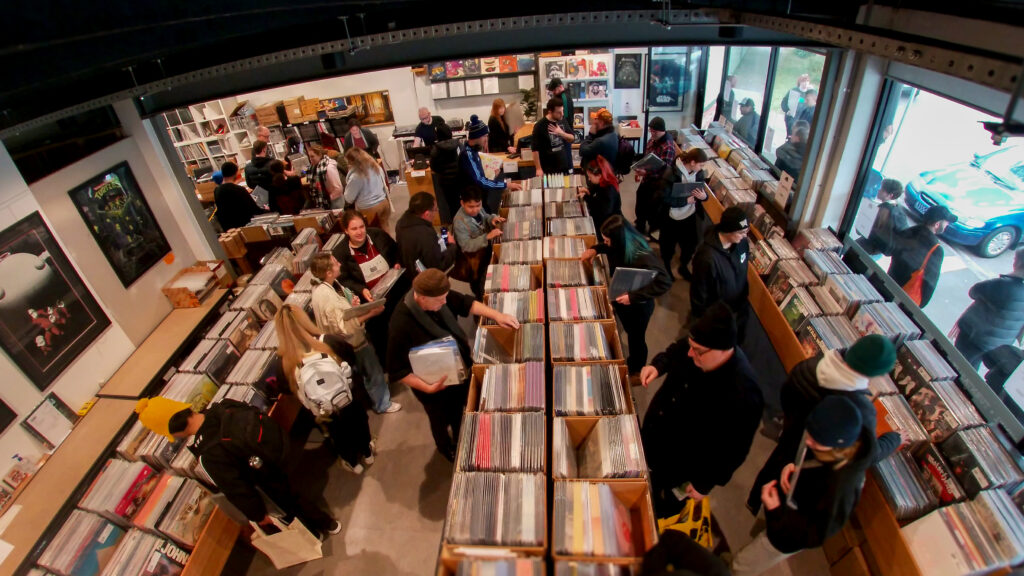Though known for their ability to conjure limitless soundscapes, Swinscoe’s early experiments were very much shaped by his limitations. “It wasn’t really conceptualised in the beginning,” says Swinscoe, speaking from his new home on Paris’ Left Bank (“I’ve spent the last seven years in the US – it felt like a natural time to come back to Europe”, he explains). “It was just a love of art and music, and trying to fuse the two together. I collected a lot of old records – jazz, experimental, classical, a lot of film scores – and I had [in the late ‘90s] an old Mac computer, an Akai sampler and some turntables. So my tools were very limited, but I think that’s the best way to go, because it makes you experiment, makes you think harder about what you can create with a small palette.”
So The Cinematic Orchestra wasn’t conceived as part of a master plan, but Swinscoe certainly knew what he wasn’t interested in doing. Of the music that eventually made up debut album Motion, a score for an imaginary thriller, Swinscoe says that he was “trying to create a narrative through the composition. I never wanted to write three-minute pop songs for the radio. I wanted something longer and more emotive, something that could develop over time.
In the course of discussing Swinscoe’s craft, it becomes clear the he possesses an enduring curiosity, which goes some way to explaining the varied projects that the group have taken on throughout their career. “We’ve played some amazing shows”, he says, “ancient European amphitheatres, film festivals…one of our first shows was playing at the Director’s Guild Awards, where Stanley Kubrick was receiving a lifetime achievement award. They kitted us out to look like a boy band, all matching, and we just played our music in the corner. It was bizarre, but rewarding.”
“Then there’s the live scores that we’ve done for films – we played Man With A Movie Camera for thousands of people, the Barbican [the band curated a series of film scores for silent films at London’s Barbican Centre in 2011]. I think the name and the style of music has gotten us invited to some very special places. We’ve played rock festivals, like Fuji Rock, and that can be hard – getting onstage after a hard, pumping rock band in front of ten thousand people. We still enjoy the challenge, but maybe that environment isn’t the most conducive to what we do.”
Such a will to explore new terrain extends to their ever-changing sound. “Motion was sample-based, and Every Day was more based on the sound of a live band. Then from Every Day to Ma Fleur was a dislocation, from dance music to songwriting with less beats, more of a new folk music. The one I’m working on now is more electronic, with programmed beats and a very different palette of sounds – synths, organs and effects.”
That palette of sounds lends itself wonderfully to television, and many of The Cinematic Orchestra’s fans were first exposed to the band through the soundtracks of shows like Grey’s Anatomy and Packed To The Rafters. Such commercial entanglements can presents creative and ethical challenges, but Swinscoe has a fool-proof strategy. “We get a lot of requests for TV, advertising and film, and if it’s not cool, we turn them down,” Swinscoe explains, “but Grey’s Anatomy is a good show with a good rep. We synced a song to Breaking Bad recently, and I love that show – it offers an insight into the dark side of America. I’ve no problem syncing with shows like that – it exposes us to a new audience that we never could have reached.”
The Cinematic Orchestra’s Melbourne Festival appearance will be something special, not only for concert-goers, but for the band themselves. it’s going to be a refreshed band – new bass player, new pianist – and there will be a full orchestra, which really opens the music out. Other orchestral things we’ve written have been for a string quartet, but we’ll be playing with a 24-piece string section, then woodwind and brass – it’s very sumptuous and grand, but there will be a lot of improvisation, and left turns, and sudden turns. It’ll be an exciting show.”
BY EDWARD SHARP-PAUL







